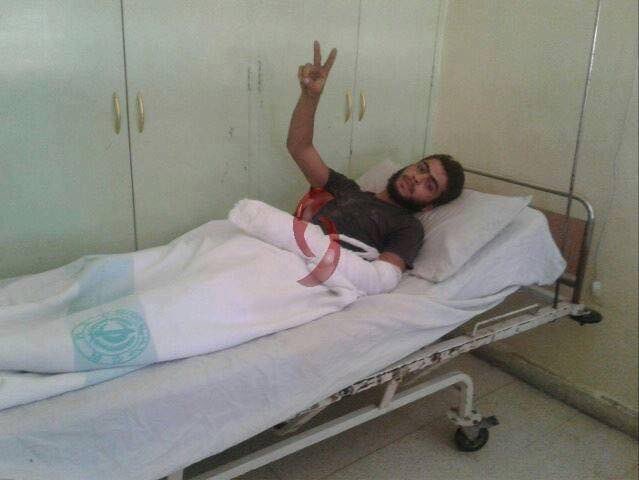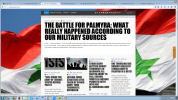Australia clears itself of blame in Deir ez-Zor bombing, watches on as Palmyra falls to ISIS
Previously published (13/12/16) on Russia Insider. See also: Reports: Audio recording between ISIS and US before Deir Ezzor massacre found (26/9/16) | Ron Paul Forums, US attack on Syrian Army in Deir Ezzor was ‘coordinated’ (30/11//16) by Paul Antonopoulos | Al Masdar News, Australian jets participated in massacre of Syrian soldiers in Deir ez-Zor (18/9/16) by Paul Antonopoulos | Al Masdar News.




A US investigation found the coalition 'botched' a strike in Deir ez-Zor, hitting the Syrian Army by mistake. Why did they not return to kill the IS fighters who moved in, or the IS fighters who just moved back to Palmyra?
Following a two-month investigation into the US coalition attack on a Syrian Army base in Deir al Zour in September, the Defence departments of the US and Australia concluded that the 'botched' strike was a result of poor information and human error, and no-one will face charges over the 'incident'.
Australia's chief of Joint Military Operations, David Johnston described it thus in a prepared statement:
"Although the identity of those killed or wounded could not be substantiated, the investigation found it was more likely than not that those struck were irregular forces aligned to the Syrian government.
"The situation on the ground in Syria is complex and dynamic. In many ways these forces looked and acted like Da'esh fighters the coalition has been targeting for the last two years. They were not wearing recognisable military uniforms, or displaying identifying flags or markings."

This conspicuously 'false news' from such a well-briefed source is deeply worrying, particularly as its release coincided with the Syrian Army's 'hour of glory' as it liberates Aleppo's trapped civilians from the four-year long insurgent siege.
Despite the lengthy 'investigation', carried out by the very same people who ordered and executed the murderous attack on the Syrian soldiers defending Deir al Zour from IS, the report's conclusions only confirm the false statements made to the press at the time, though embroidering them with an elaborate cover story. For the hundreds of Syrian victims of this dastardly attack and their families, any confidence in the statements and behaviour of their foreign attackers is now permanently destroyed.
How galling for those families, whose heroic husbands, sons and brothers had held their ground for two years against constant assaults from IS insurgents, to read that 'their identities could not be substantiated'. Or that these members of the Syrian Arab Army's 123rd Republican guard were mere 'irregulars aligned to the Syrian government'.
Never mind the testimony of some of the injured soldiers from hospital broadcast on Syrian state TV, describing the aggression and persistence of their attackers, or their still more incriminating statements that IS fighters moved in to take over the base before their comrades blood was even dry.
Although the US coalition's story is a complete travesty, it deserves closer scrutiny both for what it says and what it leaves out.
While novel unsubstantiated and false allegations are made about the nature of the target, the Australian Defence Forces have admitted responsibility for likely causing some of the deaths of Syrian soldiers - claiming that Australian war-planes had launched six laser-guided missiles, at what they identified as Da'esh fighters.
Since Australia 'joined the US coalition against Da'esh' two years ago, training soldiers in the Iraqi army, Australia's position on the fight against Da'esh in Syria has been obscure, and air-strikes within Syria notionally limited to preventing Da'esh from threatening Iraq. The silence of the Australian government, and the failure of the national broadcaster the ABC to ask questions about our actions against terrorist groups in Syria, contrasts sharply with the rhetoric from both sides of government here for the last five years, both against terrorism and against the Syrian government.
Not only has Australia been a central member of the 'Friends of Syria' group, and a vocal supporter of the Syrian external Opposition, but its anti-Russian and anti-Putin statements and actions have made it one of the most important partners in the NATO war on Syria. Some of that anti-Russian rhetoric is connected with Australia's support for Kiev's post-coup government, and reaction to the deaths of 38 Australians on board MH17. A recent agreement to supply Uranium to Ukraine hardly bodes for our future dealings with Moscow.
In the absence of any sensible discussion or analysis in the Australian media about the Deir al Zour attack and its actual consequences, or how the change in US leadership and likely direction in Syria could affect Australia's strategic position and military involvements in the region, some further investigation is now called for.
In the meantime, and as has happened repeatedly during the Syrian conflict, a resolution of that conflict in one area sees a resumption of it elsewhere. This 'two-steps forward, one back' - or three back - progress of the war is largely why it has taken the Syrian Army and its allies over two years to liberate Aleppo from its insurgent grip.
Of particular interest to those seeking to understand the objectives and allegiances of Syria's foreign invaders and their 'puppet-masters', is a surprising and disturbing development - the reappearance of IS forces in Palmyra.
Palmyra, like Deir al Zour, was stoically defended by the Syrian army until IS forces moved in, controversially crossing hundreds of kilometres of open desert without being noticed by the 'US coalition against IS'. (perhaps they were mistaken for Syrian troops?) In one of Russia's first acts demonstrating that it was serious about fighting and killing terrorist forces in Syria, Russian airpower helped the Syrian Army liberate the historic city and adjacent town of Tadmor ten months later.
But in a situation which is almost a mirror image of that existing today, terrorist groups including IS south of Aleppo took advantage of the Syrian Army's focus on Palmyra to seize control over the main highway linking Aleppo with Damascus, cutting off the Syrian Army contingent protecting Western Aleppo from the insurgents in the East.
As Oscar Wilde said: "to lose one parent may be regarded as misfortune; to lose both looks like carelessness."
To strike the Syrian Army while targeting IS may be a 'blunder'; to fail to target IS as it again targets the Syrian Army looks like more than carelessness, and a lot like collusion. And we should ask, why did the US coalition forces not immediately return to kill those Da'esh fighters who moved into the Deir al Zour base that they had just inadvertently 'liberated' of its patriotic Syrian forces in September?
Vice Admiral David Johnston didn't answer that question - but neither was he asked it.
As a virtual postscript, and indication that things are really changing on the ground in Syria even while they remain stagnant in the minds of her foreign 'false friends', it appears that Palmyra has already be re-liberated, with many IS fighters killed in a joint Russian-Syrian operation.
And so we won't be subjected to another call to 'intervene to protect Syria's ancient heritage - from IS terrorists'.
1. ↑The images are from the abovementioned Reports: Audio recording between ISIS and US before Deir Ezzor massacre found
(26/9/16) by Ron Paul | Ron Paul Forums.

 (Republished from article by Ziad Fadel on Syrian Perspective news site published at about 0100 hrs 22 May Australian time, titled, "The Battle for Palmyra: What really happened according to our military sources" at
(Republished from article by Ziad Fadel on Syrian Perspective news site published at about 0100 hrs 22 May Australian time, titled, "The Battle for Palmyra: What really happened according to our military sources" at 

 News reports have begun to come in about the fall of Palmyra to ISIS in Syria, and while most Western media has rightly been concerned with the city’s ancient ruins, few mentions have been given to the welfare of the people living in the region, or the fact that “The Syrian army launched a massive operation to evacuate as many civilians as possible of the city’s 100,000 inhabitants before its epic defeat.” (
News reports have begun to come in about the fall of Palmyra to ISIS in Syria, and while most Western media has rightly been concerned with the city’s ancient ruins, few mentions have been given to the welfare of the people living in the region, or the fact that “The Syrian army launched a massive operation to evacuate as many civilians as possible of the city’s 100,000 inhabitants before its epic defeat.” (
 Candobetter.net has been informed of an urgent call from Syria this morning to
Candobetter.net has been informed of an urgent call from Syria this morning to  For those who don't know the story of Queen Zenobia, this is a good time to read up on it. Her story is known by every Syrian. For some time, she was victorious against the Roman Empire.
For those who don't know the story of Queen Zenobia, this is a good time to read up on it. Her story is known by every Syrian. For some time, she was victorious against the Roman Empire.
Recent comments